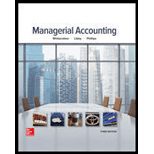
Managerial Accounting
3rd Edition
ISBN: 9780077826482
Author: Stacey M Whitecotton Associate Professor, Robert Libby, Fred Phillips Associate Professor
Publisher: McGraw-Hill Education
expand_more
expand_more
format_list_bulleted
Question
Chapter 13, Problem 2.2GAP
To determine
Introduction:
Profit margin ratio is calculated by dividing net income by the net sales. It helps in calculating the of net income as a percentage of revenue.
To calculate:
The net profit margin for previous and current year and comment on the same.
Expert Solution & Answer
Want to see the full answer?
Check out a sample textbook solution
Students have asked these similar questions
I am looking for a step-by-step explanation of this financial accounting problem with correct standards.
Can you solve this general accounting question with accurate accounting calculations?
Elba Industries recently reported an EBITDA of $12.5 million and a net income of $3.7 million. It had $3.2 million in interest expense, and its corporate tax rate was 40%. What was its charge for depreciation and amortization?
Chapter 13 Solutions
Managerial Accounting
Ch. 13 - Prob. 1QCh. 13 - Prob. 2QCh. 13 - What is ratio analysis? Why is it useful?
Ch. 13 - What benchmarks are commonly used for interpreting...Ch. 13 - Prob. 5QCh. 13 - Why are some analyses called horizontal and others...Ch. 13 - Slow Cellar’s current ratio increased from 1.2 to...Ch. 13 - From last year to this year. Colossal Company’s...Ch. 13 - From last year to this year, Berry Barn reported...Ch. 13 - Prob. 10Q
Ch. 13 - Prob. 1MCCh. 13 - Prob. 2MCCh. 13 - Prob. 3MCCh. 13 - Prob. 4MCCh. 13 - Prob. 5MCCh. 13 - Prob. 6MCCh. 13 - Prob. 7MCCh. 13 - Prob. 8MCCh. 13 - Prob. 9MCCh. 13 - Prob. 1MECh. 13 - Prob. 2MECh. 13 - Prob. 3MECh. 13 - Prob. 4MECh. 13 - Prob. 5MECh. 13 - Prob. 6MECh. 13 - Prob. 7MECh. 13 - Prob. 8MECh. 13 - Prob. 9MECh. 13 - Prob. 10MECh. 13 - Prob. 11MECh. 13 - Prob. 12MECh. 13 - Prob. 13MECh. 13 - Prob. 14MECh. 13 - Prob. 1ECh. 13 - Prob. 2ECh. 13 - Prob. 3ECh. 13 - Prob. 4ECh. 13 - Prob. 5ECh. 13 - Prob. 6ECh. 13 - Prob. 7ECh. 13 - Computing and Interpreting Liquidity Ratios...Ch. 13 - Prob. 9ECh. 13 - Prob. 10ECh. 13 - Prob. 11ECh. 13 - Prob. 12ECh. 13 - Prob. 13ECh. 13 - Analyzing the Impact of Selected Transactions on...Ch. 13 - Prob. 15ECh. 13 - Prob. 1.1GAPCh. 13 - Prob. 1.2GAPCh. 13 - Prob. 2.1GAPCh. 13 - Prob. 2.2GAPCh. 13 - Prob. 2.3GAPCh. 13 - Prob. 2.4GAPCh. 13 - Prob. 2.5GAPCh. 13 - Prob. 2.6GAPCh. 13 - Prob. 2.7GAPCh. 13 - Prob. 2.8GAPCh. 13 - Prob. 3.1GAPCh. 13 - Prob. 3.2GAPCh. 13 - Prob. 3.3GAPCh. 13 - Prob. 4.1GAPCh. 13 - Prob. 4.2GAPCh. 13 - Prob. 4.3GAPCh. 13 - Prob. 5.1GAPCh. 13 - Prob. 5.2GAPCh. 13 - Prob. 5.3GAPCh. 13 - Prob. 5.4GAPCh. 13 - Prob. 6.1GAPCh. 13 - Prob. 6.2GAPCh. 13 - Prob. 7GAPCh. 13 - Prob. 1.1GBPCh. 13 - Prob. 1.2GBPCh. 13 - Prob. 2.1GBPCh. 13 - Prob. 2.2GBPCh. 13 - Prob. 2.3GBPCh. 13 - Prob. 2.4GBPCh. 13 - Prob. 2.5GBPCh. 13 - Prob. 2.6GBPCh. 13 - Prob. 2.7GBPCh. 13 - Prob. 2.8GBPCh. 13 - Prob. 3.1GBPCh. 13 - Prob. 3.2GBPCh. 13 - Prob. 3.3GBPCh. 13 - Prob. 4.1GBPCh. 13 - Prob. 4.2GBPCh. 13 - Prob. 4.3GBPCh. 13 - Prob. 5.1GBPCh. 13 - Prob. 5.2GBPCh. 13 - Prob. 5.3GBPCh. 13 - Prob. 5.4GBPCh. 13 - Prob. 6.1GBPCh. 13 - Prob. 6.2GBPCh. 13 - Prob. 7GBP
Knowledge Booster
Similar questions
- Please explain the correct approach for solving this general accounting question.arrow_forwardI am trying to find the accurate solution to this general accounting problem with the correct explanation.arrow_forwardBrightview Components Ltd. expected an overhead cost of $425,000 for its packaging cost pool and an estimated 17,000 packaging operations. The actual overhead cost for that cost pool was $460,000for 18,200 actual packaging operations. The activity-based overhead rate (ABOR) used to assign the costs of the packaging cost pool to products is __arrow_forward
- Elba Industries recently reported an EBITDA of $12.5 million and a net income of $3.7 million. It had $3.2 million in interest expense, and its corporate taxrate was 40%. What was its charge for depreciation and amortization?arrow_forwardPedro Manufacturing expects overhead costs of $360,000 per year and direct production costs of $15 per unit. The estimated production activity for the 2023 accounting period is as follows: 1st 2nd 3rd 4th Quarter Units Produced 10,000 9,500 8,000 10,500| The predetermined overhead rate based on units produced is (rounded to the nearest penny): a. $9.47 per unit b. $10.00 per unit c. $8.05 per unit d. $11.25 per unitarrow_forwardPlease provide the answer to this general accounting question with proper steps.arrow_forward
arrow_back_ios
SEE MORE QUESTIONS
arrow_forward_ios
Recommended textbooks for you
 Managerial AccountingAccountingISBN:9781337912020Author:Carl Warren, Ph.d. Cma William B. TaylerPublisher:South-Western College Pub
Managerial AccountingAccountingISBN:9781337912020Author:Carl Warren, Ph.d. Cma William B. TaylerPublisher:South-Western College Pub College Accounting, Chapters 1-27AccountingISBN:9781337794756Author:HEINTZ, James A.Publisher:Cengage Learning,Century 21 Accounting Multicolumn JournalAccountingISBN:9781337679503Author:GilbertsonPublisher:Cengage
College Accounting, Chapters 1-27AccountingISBN:9781337794756Author:HEINTZ, James A.Publisher:Cengage Learning,Century 21 Accounting Multicolumn JournalAccountingISBN:9781337679503Author:GilbertsonPublisher:Cengage Cornerstones of Financial AccountingAccountingISBN:9781337690881Author:Jay Rich, Jeff JonesPublisher:Cengage Learning
Cornerstones of Financial AccountingAccountingISBN:9781337690881Author:Jay Rich, Jeff JonesPublisher:Cengage Learning Managerial Accounting: The Cornerstone of Busines...AccountingISBN:9781337115773Author:Maryanne M. Mowen, Don R. Hansen, Dan L. HeitgerPublisher:Cengage Learning
Managerial Accounting: The Cornerstone of Busines...AccountingISBN:9781337115773Author:Maryanne M. Mowen, Don R. Hansen, Dan L. HeitgerPublisher:Cengage Learning College Accounting (Book Only): A Career ApproachAccountingISBN:9781337280570Author:Scott, Cathy J.Publisher:South-Western College Pub
College Accounting (Book Only): A Career ApproachAccountingISBN:9781337280570Author:Scott, Cathy J.Publisher:South-Western College Pub

Managerial Accounting
Accounting
ISBN:9781337912020
Author:Carl Warren, Ph.d. Cma William B. Tayler
Publisher:South-Western College Pub

College Accounting, Chapters 1-27
Accounting
ISBN:9781337794756
Author:HEINTZ, James A.
Publisher:Cengage Learning,

Century 21 Accounting Multicolumn Journal
Accounting
ISBN:9781337679503
Author:Gilbertson
Publisher:Cengage

Cornerstones of Financial Accounting
Accounting
ISBN:9781337690881
Author:Jay Rich, Jeff Jones
Publisher:Cengage Learning

Managerial Accounting: The Cornerstone of Busines...
Accounting
ISBN:9781337115773
Author:Maryanne M. Mowen, Don R. Hansen, Dan L. Heitger
Publisher:Cengage Learning

College Accounting (Book Only): A Career Approach
Accounting
ISBN:9781337280570
Author:Scott, Cathy J.
Publisher:South-Western College Pub